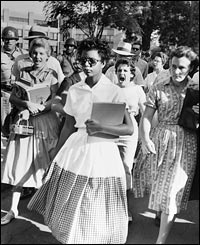The Courage of the Little Rock Nine
 Fifty years ago today, nine black teenagers, escorted by federal troops, walked through an angry white mob into Central High School in Little Rock Arkansas. Today, we need to remember their courage. We need to celebrate their achievement, their contribution to the Civil Rights Movement that moved this country so much further toward the fulfillment of its promise of freedom. But we also need to take inspiration from their story to engage in the unfinished work of ending the blight of racism forever.
Fifty years ago today, nine black teenagers, escorted by federal troops, walked through an angry white mob into Central High School in Little Rock Arkansas. Today, we need to remember their courage. We need to celebrate their achievement, their contribution to the Civil Rights Movement that moved this country so much further toward the fulfillment of its promise of freedom. But we also need to take inspiration from their story to engage in the unfinished work of ending the blight of racism forever.
National Public Radio has aired a terrific series on the Little Rock story, which you can listen to from their website. Particularly moving is an interview with three of the Little Rock Nine, including Elizbeth Eckford, whose grace walking through faces contorted with hatred in the picture above became an iconic moment in the Civil Rights Movement. The courage of these students shines through this interview, as they describe what they endured not just that day fifty years ago but throughout their careers at Central High.
The unfolding story of the Jena 6 makes clear that we still must work to eradicate racism. Sadder still is the fact that, fifty years after Little Rock, de facto segregation on a level that rivals the days of Jim Crow remains the norm in school districts across America. Education reformer Jonathan Kozol described the problem vividly in a 2005 article in Harpers:
In Chicago, by the academic year 2002-2003, 87 percent of public-school enrollment was black or Hispanic; less than 10 percent of children in the schools were white. In Washington, D.C., 94 percent of children were black or Hispanic; less than 5 percent were white. In St. Louis, 82 percent of the student population were black or Hispanic; in Philadelphia and Cleveland, 79 percent; in Los Angeles, 84 percent, in Detroit, 96 percent; in Baltimore, 89 percent. In New York City, nearly three quarters of the students were black or Hispanic.
Even these statistics, as stark as they are, cannot begin to convey how deeply isolated children in the poorest and most segregated sections of these cities have become. In the typically colossal high schools of the Bronx, for instance, more than 90 percent of students (in most cases, more than 95 percent) are black or Hispanic. At John F. Kennedy High School in 2003, 93 percent of the enrollment of more than 4,000 students were black and Hispanic; only 3.5 percent of students at the school were white. At Harry S. Truman High School, black and Hispanic students represented 96 percent of the enrollment of 2,700 students; 2 percent were white. At Adlai Stevenson High School, which enrolls 3,400 students, blacks and Hispanics made up 97 percent of the student population; a mere eight tenths of one percent were white.
A teacher at P.S. 65 in the South Bronx once pointed out to me one of the two white children I had ever seen there. His presence in her class was something of a wonderment to the teacher and to the other pupils. I asked how many white kids she had taught in the South Bronx in her career. `I’ve been at this school for eighteen years,” she said. “This is the first white student I have ever taught.’
I often share a personal story to try and illustrate the lack of resources that this de facto segregation produces in even a good urban school. When we lived in Baltimore for a few years, our son attended a public school on the edge of the city for the third and fourth grade. He was one of 2 or 3 students of European descent in a K-5 school of 950 students. Though there were certainly some difficult moments, on the whole I think it was a positive experience for him. Thanks to the hard work of the teachers, and in particular the principal — an African Ameican woman who was actually unable to attend the school as a child when it opened in 1954 because of lingering segregation — the school was a success story in the Baltimore system. But as parents, one of our frustrations was that so often we would not find out about things in a timely way — why can’t they send a note home, we wondered? The answer I learned was that there was one photocopier, and not a new one, for the entire school, and it was frequently broken. When we moved here to the Happy Valley, with its well-funded, high achieving school district, I went to parents night, and the first thing I noted was that each classroom had access to a networked laser printer.
This is obviously a relatively minor inequality, but it has real consequences for the schools. In this article and in his book Shame of the Nation, Kozol describes much more devastating inequalities that the return to a de facto apartheid educational system imposes.
This was a great help for my research paper. It gave me a lot of crutial information.
i did not like this site at all
aaaaaaaaaaaaaaaaaaaaaaaaaaaaaaaaaaaaaaaaaaaaaaaaaaaaaaaaaaaaaaaaaaaaaaaaaaaaaaaaaaaaaaaaaaaaaaaaaaaaaaaaaaaaaaaaaaaaaaaaaaaaaaaaaaaaaaaaaaaaaaaaaaaaaaaaaaaaaaaaaaaaaaaaaaaaaaaaaaaaaaaaaaaa aaaaaaaaaaaaaaaaaaaaaaaaaaaaaaaaaaaaaaaaaaaaaaaaaaaaaaaaaaaaaaaaaaaaaaaaaaaaaaaaaaaaaaaaaaaaaaaaaaaaaaaaaaaaaaaaaaaaaaaaaaaaaaaaaaaaaaaaaaaaaaaaaaaaaaaaaaaaaaaaaaaaaaaaaaaaaaaaaaaaaaaaaaaa aaaaaaaaaaaaaaaaaaaaaaaaaaaaaaaaaaaaaaaaaaaaaaaaaaaaaaaaaaaaaaaaaaaaaaaaaaaaaaaaaaaaaaaaaaaaaaaaaaaaaaaaaaaaaaaaaaaaaaaaaaaaaaaaaaaaaaaaaaaaaaaaaaaaaaaaaaaaaaaaaaaaaaaaaaaaaaaaaaaaaaaaaaaa aaaaaaaaaaaaaaaaaaaaaaaaaaaaaaaaaaaaaaaaaaaaaaaaaaaaaaaaaaaaaaaaaaaaaaaaaaaaaaaaaaaaaaaaaaaaaaaaaaaaaaaaaaaaaaaaaaaaaaaaaaaaaaaaaaaaaaaaaaaaaaaaaaaaaaaaaaaaaaaaaaaaaaaaaaaaaaaaaaaaaaaaaaaa aaaaaaaaaaaaaaaaaaaaaaaaaaaaaaaaaaaaaaaaaaaaaaaaaaaaaaaaaaaaaaaaaaaaaaaaaaaaaaaaaaaaaaaaaaaaaaaaaaaaaaaaaaaaaaaaaaaaaaaaaaaaaaaaaaaaaaaaaaaaaaaaaaaaaaaaaaaaaaaaaaaaaaaaaaaaaaaaaaaaaaaaaaaa aaaaaaaaaaaaaaaaaaaaaaaaaaaaaaaaaaaaaaaaaaaaaaaaaaaaaaaaaaaaaaaaaaaaaaaaaaaaaaaaaaaaaaaaaaaaaaaaaaaaaaaaaaaaaaaaaaaaaaaaaaaaaaaaaaaaaaaaaaaaaaaaaaaaaaaaaaaaaaaaaaaaaaaaaaaaaaaaaaaaaaaaaaaa aaaaaaaaaaaaaaaaaaaaaaaaaaaaaaaaaaaaaaaaaaaaaaaaaaaaaaaaaaaaaaaaaaaaaaaaaaaaaaaaaaaaaaaaaaaaaaaaaaaaaaaaaaaaaaaaaaaaaaaaaaaaaaaaaaaaaaaaaaaaaaaaaaaaaaaaaaaaaaaaaaaaaaaaaaaaaaaaaaaaaaaaaaaa aaaaaaaaaaaaaaaaaaaaaaaaaaaaaaaaaaaaaaaaaaaaaaaaaaaaaaaaaaaaaaaaaaaaaaaaaaaaaaaaaaaaaaaaaaaaaaaaaaaaaaaaaaaaaaaaaaaaaaaaaaaaaaaaaaaaaaaaaaaaaaaaaaaaaaaaaaaaaaaaaaaaaaaaaaaaaaaaaaaaaaaaaaaa aaaaaaaaaaaaaaaaaaaaaaaaaaaaaaaaaaaaaaaaaaaaaaaaaaaaaaaaaaaaaaaaaaaaaaaaaaaaaaaaaaaaaaaaaaaaaaaaaaaaaaaaaaaaaaaaaaaaaaaaaaaaaaaaaaaaaaaaaaaaaaaaaaaaaaaaaaaaaaaaaaaaaaaaaaaaaaaaaaaaaaaaaaaa aaaaaaaaaaaaaaaaaaaaaaaaaaaaaaaaaaaaaaaaaaaaaaaaaaaaaaaaaaaaaaaaaaaaaaaaaaaaaaaaaaaaaaaaaaaaaaaaaaaaaaaaaaaaaaaaaaaaaaaaaaaaaaaaaaaaaaaaaaaaaaaaaaaaaaaaaaaaaaaaaaaaaaaaaaaaaaaaaaaaaaaaaaaa aaaaaaaaaaaaaaaaaaaaaaaaaaaaaaaaaaaaaaaaaaaaaaaaaaaaaaaaaaaaaaaaaaaaaaaaaaaaaaaaaaaaaaaaaaaaaaaaaaaaaaaaaaaaaaaaaaaaaaaaaaaaaaaaaaaaaaaaaaaaaaaaaaaaaaaaaaaaaaaaaaaaaaaaaaaaaaaaaaaaaaaaaaaa aaaaaaaaaaaaaaaaaaaaaaaaaaaaaaaaaaaaaaaaaaaaaaaaaaaaaaaaaaaaaaaaaaaaaaaaaaaaaaaaaaaaaaaaaaaaaaaaaaaaaaaaaaaaaaaaaaaaaaaaaaaaaaaaaaaaaaaaaaaaaaaaaaaaaaaaaaaaaaaaaaaaaaaaaaaaaaaaaaaaaaaaaaaa aaaaaaaaaaaaaaaaaaaaaaaaaaaaaaaaaaaaaaaaaaaaaaaaaaaaaaaaaaaaaaaaaaaaaaaaaaaaaaaaaaaaaaaaaaaaaaaaaaaaaaaaaaaaaaaaaaaaaaaaaaaaaaaaaaaaaaaaaaaaaaaaaaaaaaaaaaaaaaaaaaaaaaaaaaaaaaaaaaaaaaaaaaaa thats good.